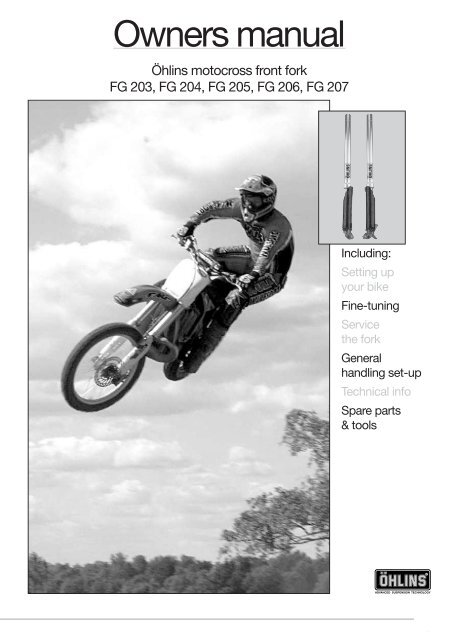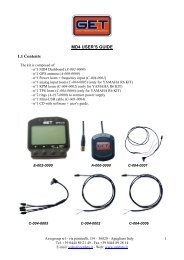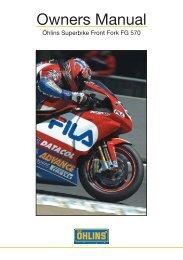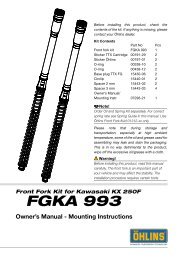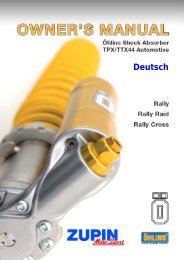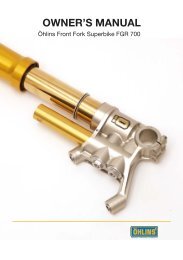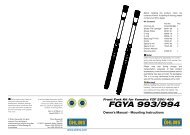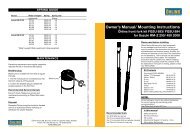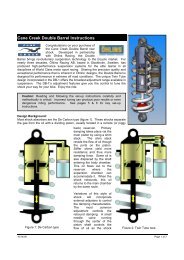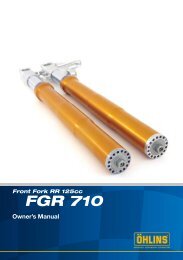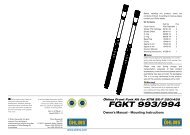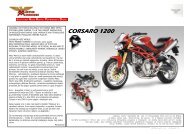Download - Zupin
Download - Zupin
Download - Zupin
You also want an ePaper? Increase the reach of your titles
YUMPU automatically turns print PDFs into web optimized ePapers that Google loves.
Owners manual<br />
Öhlins motocross front fork<br />
FG 203, FG 204, FG 205, FG 206, FG 207<br />
Including:<br />
Setting up<br />
your bike<br />
Fine-tuning<br />
Service<br />
the fork<br />
General<br />
handling set-up<br />
Technical info<br />
Spare parts<br />
& tools<br />
1
2<br />
Safety signals<br />
Important information concerning<br />
safety is distinguished in this<br />
manual by the following notations:<br />
The Safety alert symbol means:<br />
Caution! Your safety is involved.<br />
WARNING!<br />
Failure to follow warning instructions<br />
could result in severe or<br />
fatal injury to anyone working<br />
with, inspecting or using the suspension,<br />
or to bystanders.<br />
CAUTION!<br />
Caution indicates that special<br />
precautions must be taken to<br />
avoid damage to the suspension.<br />
NOTE!<br />
This indicates information that is<br />
of importance with regard to procedures.<br />
Öhlins motocross<br />
front fork MX 02<br />
© Öhlins Racing AB.<br />
All rights reserved.<br />
Any reprinting or unauthorized use<br />
without the written permission of<br />
Öhlins Racing AB is prohibited.<br />
Printed in Sweden.<br />
Before installation<br />
Öhlins Racing AB can not be held<br />
responsible for any damage whatsoever<br />
to shock absorber or vehicle,<br />
or injury to persons, if the instructions<br />
for fitting and maintenance are<br />
not followed exactly.<br />
Similarly, the warranty will become<br />
null and void if the instructions are<br />
not adhered to.<br />
WARNING!<br />
1. Installing a front fork, that is not<br />
approved by the vehicle manufacturer,<br />
may affect the stability of your<br />
vehicle. Öhlins Racing AB cannot<br />
be held responsible for any personal<br />
injury or damage whatsoever<br />
that may occur after fitting the front<br />
fork. Contact an Öhlins dealer or<br />
other qualified person for advice.<br />
2. Please study and make certain<br />
that you fully understand all the<br />
mounting instructions and the owners<br />
manuals before handling this<br />
front fork kit. If you have any questions<br />
regarding proper installation<br />
procedures, contact an Öhlins<br />
dealer or other qualified person.<br />
3. The vehicle service manual must<br />
be referred to when installing the<br />
Öhlins front fork.<br />
Öhlins products are subject to continual<br />
improvement and development.<br />
Consequently, although these<br />
instructions include the most up-todate<br />
information available at the time<br />
of printing, there may be minor differences<br />
between your suspension<br />
and this manual. Please consult your<br />
Öhlins dealer if you have any<br />
questions with regard to the contents<br />
of the manual.<br />
NOTE!<br />
During storage and transportation,<br />
especially at high ambient temperature,<br />
the oil and grease used for<br />
assembling may run out inside the<br />
packing and damage the expanded<br />
polystyrene packing material. This is<br />
not unusual and is in no way detrimental<br />
to the shock absorber.<br />
Contents<br />
Safety signals ............................. 2<br />
Introduction................................ 3<br />
Design ....................................... 3<br />
Before you start ......................... 3<br />
Marking...................................... 3<br />
Recommended settings ............. 3<br />
Mounting instructions ................. 4<br />
Setting up the bike ..................... 4<br />
Checking front sag ..................... 4<br />
Checking rear sag ...................... 4<br />
Checking front ride height .......... 5<br />
Checking rear ride height ........... 5<br />
Fine-tuning the bike ................... 5<br />
Making adjustments ................... 6<br />
Oil level adjustment .................... 6<br />
Maintenance .............................. 6<br />
General handling set-up ............. 7<br />
Preload adjustment .................... 8<br />
Changing springs ....................... 9<br />
Dismantling the front fork ......... 10<br />
Assembly of the front fork ........ 11<br />
Service tools ............................ 13<br />
Technical specifications............ 13<br />
Spare parts .............................. 14
Introduction<br />
Öhlins Racing congratulates you on<br />
your choice of front fork for your motocross<br />
bike.<br />
All Öhlins products are designed<br />
with just one aim; to win races. To<br />
design a winner you need a concept<br />
starting with a unique know-how.<br />
You add engineering skill, precision<br />
and the best material available. The<br />
result is quality, endurance and winning<br />
performance.<br />
Your new Öhlins front fork is developed<br />
from experience gained during<br />
years of successful cooperation with<br />
the World Championship winning<br />
works motocross teams.<br />
Spring rates and damping forces<br />
are developed just for your bike. The<br />
design and the settings are consequently<br />
the results of extensive testing<br />
and no guesswork!<br />
Öhlins shock absorbers and front<br />
forks have dominated the motorcycle<br />
scene for several years and have<br />
captured more World Championship<br />
titles than any other brand, over 80<br />
titles!<br />
A well equipped network of authorised<br />
Öhlins service centres around<br />
the world, with specially trained mechanics,<br />
can help you with personally<br />
tuned settings, service, repairs<br />
and spare parts.<br />
Design<br />
Öhlins new up-side-down (USD)<br />
front fork is designed to combine the<br />
advantages of comfortable, safe<br />
conventional forks and rigid, light<br />
USD forks. The result is a unique<br />
combination of being rigid, precise<br />
in corners and during hard braking<br />
yet comfortable, forgiving when<br />
“over-landing“ and in big bumps.<br />
Your new Öhlins USD front fork has<br />
aluminium outer legs and 46 mm<br />
steel inner legs, with a polished surface<br />
for lowest possible friction.<br />
The legs also feature a completely<br />
new bushing design with fixed and<br />
one sliding bushing.<br />
The new USD fork features the<br />
Öhlins championship winning cartridge<br />
damping system.<br />
The fork is fully adjustable with<br />
external adjuster for compressionand<br />
rebound damping.<br />
The compression adjuster is lo-<br />
cated at the bottom of the fork leg,<br />
fig 1, the rebound adjuster at the top,<br />
fig 2.<br />
The spring preload is adjusted<br />
externaly on the top of the fork.<br />
In the legs there are also “airsprings“<br />
(the air trapped above the<br />
oil) that work together with the “real“<br />
spring. You adjust the air-spring by<br />
raising or lowering the oil level in the<br />
legs.<br />
By using different combinations of<br />
springs and air-springs you can alter<br />
the characteristic of the fork. For<br />
example, a soft spring in combination<br />
with a small air-spring (high oil<br />
level) makes the fork progressive,<br />
see “Fine-tuning the bike“.<br />
Marking<br />
All Öhlins front forks are marked. You<br />
will find the part number on the inside<br />
of the fork bottom.<br />
Your Öhlins front fork has the following<br />
marking:<br />
FG 203 KTM<br />
FG 204 Yamaha<br />
FG 205 Kawasaki<br />
FG 206 Suzuki<br />
FG 207 Honda<br />
Recommended settings<br />
The front fork in your kit is adjusted<br />
to the Öhlins recommended setting<br />
for your bike, see “Making adjustments“.<br />
We advise you to use this<br />
as your start setting.<br />
Mounting instructions<br />
WARNING<br />
1. It is advisable to have an Öhlins<br />
dealer or a qualified mechanic to<br />
fit your front fork kit.<br />
2. To install the kit you need your<br />
motorcycle’s work shop manual.<br />
3. When working on your motorcycle,<br />
support it securely so it does<br />
not fall over.<br />
The Öhlins front fork is designed to<br />
fit your bike’s standard triple clamps<br />
and to use the standard brake components<br />
and wheel.<br />
1<br />
Put your bike on a stand and remove<br />
the front wheel, the front brake components<br />
and the fork legs from the<br />
bike according to the work shop<br />
manual.<br />
CAUTION!<br />
1. The outer legs, both left and right,<br />
should be adjusted evenly in the<br />
fork crown.<br />
2. The Öhlins fork legs feature<br />
grooves on top of the outer fork legs<br />
to make adjustment of the fork<br />
height easier. The distance between<br />
the grooves is 4 mm.<br />
2<br />
Fit the Öhlins front fork legs. For recommended<br />
front fork mounting<br />
height see mounting instruction.<br />
3<br />
Fit the brake components and the<br />
front wheel according to the work<br />
shop manual.<br />
4<br />
Tighten all screws. For maximum<br />
torque, please see your bike’s work<br />
shop manual.<br />
3
4<br />
Compression adjuster<br />
1.<br />
The compression adjuster is located<br />
at the bottom of the fork leg.<br />
Rebound adjuster<br />
2.<br />
The rebound adjuster at the top of<br />
the fork leg.<br />
Preload adjustment<br />
3.<br />
Spring preload is adjusted with the<br />
nut on the top of the fork leg.<br />
Optional springs are avaliable.<br />
Setting up the bike<br />
We would like to give you some basic<br />
guidelines how to set up your bike<br />
with your new Öhlins front fork.<br />
However, remember that the front<br />
fork is just one part of your motorcycle<br />
and to get the fork to work properly<br />
the whole motorcycle has to be<br />
set up according to standards.<br />
Please follow the instructions below,<br />
see also your bike’s work shop<br />
manual.<br />
Your new front fork is dialled-in to<br />
the Öhlins recommended settings for<br />
your bike. The same goes for the rear<br />
shock absorber if you are using an<br />
Öhlins unit.<br />
All settings are based on a bike and<br />
a rider of normal weight.<br />
Depending on your own and your<br />
bike’s actual weight minor differences,<br />
between the Öhlins recommended<br />
settings and the settings<br />
you achieve, may occur. Therefore,<br />
it is always wise to start the setting<br />
up by checking!<br />
The sag effects not just only the suspension<br />
but also the rake of the front<br />
fork and therefore the overall behaviour<br />
of the bike.<br />
Checking front static sag<br />
1<br />
Put your bike on a stand.<br />
Arrange the stand so that the front<br />
wheel is off the ground and the front<br />
fork fully extended.<br />
2<br />
Measure the distance between the<br />
upper fork crown and the front wheel<br />
axle, fig 4 distance A. Make a note of<br />
the measurement.<br />
3<br />
Remove the stand. With the wheels<br />
on the ground measure the distance<br />
again, fig 4 distance B.<br />
The difference of the two measurements<br />
is the static sag.<br />
4<br />
The static sag should be 30 ± 10 mm.<br />
5<br />
If the static sag is less than 20 mm,<br />
you need to reduce spring preload.<br />
If the static sag is more than 40 mm,<br />
you need to increase spring preload.<br />
6<br />
Spring preload is adjusted with the nut<br />
on the top of the fork leg. One turn of<br />
the nut alters the preload one (1) mm.<br />
Turn clockwise to increase the<br />
preload, counter clockwise to release<br />
the preload.<br />
Checking rear static sag<br />
7<br />
Put your bike on a stand. Arrange the<br />
stand so that the rear wheel is off the<br />
ground and the rear suspension fully<br />
extended.<br />
8<br />
Measure the distance between the<br />
rear wheel axle and a point near the<br />
rear end of the seat, for example a<br />
seat bolt, fig 4 distance A.<br />
Make a note of the measurement.<br />
9<br />
Remove the stand. With the wheels<br />
on the ground measure the distance<br />
again, fig 4 distance B.<br />
The difference of the two measurements<br />
is the static sag.<br />
NOTE!<br />
Refer to mounting instruction for<br />
more specific set-up data.<br />
10<br />
The static sag should be 35 ± 5 mm.<br />
11<br />
If the static sag is less than 30 mm,<br />
you need to reduce spring preload.<br />
If the static sag is more than 40 mm,<br />
you need to increase spring preload.<br />
12<br />
Adjust the spring preload according to<br />
your rear shock mounting instruction.
Setting up the bike<br />
4.<br />
Checking sag and ride height.<br />
Front sag:<br />
A - B = 30 ± 10 mm.<br />
Front ride height:<br />
A - C = 80 ± 5 mm.<br />
Rear sag:<br />
A - B = 35 ± 5 mm.<br />
Rear ride height:<br />
A - C = 100 ± 5 mm.<br />
Checking front ride height<br />
1<br />
Put your bike on a stand.<br />
Arrange the stand so that the front wheel<br />
is off the ground and the front fork fully<br />
extended.<br />
Measure the distance between the upper<br />
fork crown and the front wheel axle,<br />
fig 4 distance A. Make a note of the<br />
measurement.<br />
2<br />
Race dressed sit on the bike, straight<br />
above the foot pegs, with the feet<br />
barely touching the ground.<br />
Have somebody to measure between<br />
the same point as before,<br />
fig 4 distance C.<br />
3<br />
The difference of the two measurements<br />
should be 80 ± 5 mm.<br />
CAUTION!<br />
Do not try to alter ride height by altering<br />
the spring preload. New springs<br />
are needed.<br />
4<br />
If you need to change the springs, see<br />
“Changing springs“ on page 9.<br />
5<br />
Stiffer springs are needed if the difference<br />
is more than 90 mm.<br />
Softer springs if the difference is less<br />
than 75 mm.<br />
Consult your Öhlins dealer for the right<br />
rate.<br />
Checking rear ride height<br />
6<br />
Put your bike on a stand. Arrange the<br />
stand so that the rear wheel is off the<br />
A: Fully extended.<br />
B: On the ground.<br />
C: Rider on.<br />
ground and the rear suspension fully<br />
extended.<br />
Measure the distance between the rear<br />
wheel axle and a point near the rear end<br />
of the seat, for example a seat bolt, fig 4<br />
distance A.<br />
Make a note of the measurement.<br />
7<br />
Race dressed sit on the bike, straight<br />
above the foot pegs, with the feet barely<br />
touching the ground. Have somebody<br />
to measure between the same point as<br />
before, fig 4 distance C.<br />
8<br />
The difference of the two measurements<br />
should be 100 ± 5 mm.<br />
CAUTION!<br />
Do not try to alter ride height by altering<br />
the spring preload. A new spring<br />
is needed.<br />
9<br />
A stiffer spring is needed if the difference<br />
is more than 105 mm.<br />
A softer spring if the difference is less<br />
than 95 mm.<br />
Consult your Öhlins dealer for a spring<br />
of the right rate.<br />
Should you still experience excessive<br />
bottoming or that the bike feels much<br />
to stiff and suspension travel is not fully<br />
used, harder/softer than normal springs<br />
may be needed for the track you are<br />
testing on.<br />
Consult your Öhlins dealer for advice!<br />
Fine-tuning the bike<br />
Learning how to use the adjusters will<br />
take time but you quickly appreciate<br />
them once you know the tricks. Even<br />
C: Rider on.<br />
B: On the ground.<br />
A: Fully extended.<br />
the specialists sometimes need a<br />
specialist!<br />
With the adjusters you optimize the<br />
suspension for your riding style and the<br />
track you are competing on.<br />
The same basic guide lines goes for<br />
both the front fork and the rear shock<br />
absorber.<br />
Too much compression damping will<br />
give you a harsh ride as your bike<br />
“jumps“ along the track.<br />
With too much rebound damping your<br />
bike will have difficulties with several<br />
bumps in a row. The suspension will not<br />
extend fast enough between bumps,<br />
your bike will ride lower and lower and<br />
eventually the suspension will bottom!<br />
External adjusters<br />
On the Öhlins front fork the adjusters<br />
are bleed valves, totally separated from<br />
each other.<br />
The compression bleed valve controls<br />
the flow in the cartridge tube during the<br />
compression stroke, the rebound bleed<br />
valve the flow during the rebound stroke.<br />
CAUTION!<br />
Using too much force when closing<br />
the adjusters will destroy important<br />
sealing surfaces.<br />
Both the adjusters have a normal righthand<br />
thread.<br />
Click position zero (0) is when the adjusters<br />
are turned clockwise to fully<br />
closed.<br />
The adjustment range, from fully<br />
closed until maximum open valve<br />
(anticlockwise), is 20 clicks.<br />
In order not to click in the wrong direction;<br />
always first close the adjuster,<br />
then dial-in the new setting.<br />
5
Air spring<br />
5.<br />
A change in oil<br />
level will effect<br />
the damping<br />
forces, not in<br />
the early stage<br />
of fork travel<br />
but a great deal<br />
in the later<br />
stage.<br />
F<br />
o<br />
r<br />
c<br />
e<br />
k<br />
g<br />
f<br />
Making adjustments<br />
To make improvements using the<br />
adjusters, it is important to understand<br />
the function of the front fork<br />
and the shock absorber and through<br />
testing learn how they effect the handling<br />
of your bike.<br />
Make sure that you have the correct<br />
springs and the correct spring<br />
preload before making any adjustments.<br />
And always start with the<br />
Öhlins recommended settings:<br />
NOTE!<br />
See mounting instruction for recommended<br />
settings.<br />
NOTE!<br />
Higher click numbers give less<br />
damping force.<br />
When making adjustments; keep<br />
notes, make adjustments one at a<br />
time... and in small steps.<br />
The adjusters should normally not<br />
be adjusted in steps of more than 2<br />
clicks at a time and not outside the<br />
usable click range.<br />
When you think you have made an<br />
improvement, go back to what you<br />
started with and double check to be<br />
sure. Pay attention to changes in conditions<br />
like tires, temperatures etc.<br />
In general, compression damping<br />
changes should be used to influence<br />
the bike’s stability and response,<br />
while rebound damping changes<br />
should be used to influence comfort<br />
and traction.<br />
6<br />
Oil level 100 mm Oil level 110 mm Oil level 120 mm Oil level 130 mm<br />
500<br />
450<br />
400<br />
350<br />
300<br />
Force<br />
250<br />
200<br />
150<br />
100<br />
50<br />
0<br />
Stroke<br />
0 20 40 60<br />
Stroke mm<br />
80 100 120<br />
When you need more damping<br />
force, you should mainly try to increase<br />
compression damping and<br />
use as little rebound damping as possible.<br />
This usually means that you gain<br />
comfort and performance in handling.<br />
Oil level adjustment<br />
As the air trapped between the oil and<br />
the top nut acts as an air-spring, a<br />
change in oil level will effect the<br />
damping forces. Not in the early<br />
stage of fork travel, but a great deal<br />
in the later stage.<br />
A general description of how the oil<br />
level/air-spring effects the damping<br />
forces are shown in fig 5.<br />
The air-spring gives the Öhlins USD<br />
fork a progressive spring rate, preventing<br />
it from bottoming out hard.<br />
By using different combinations of<br />
springs and oil levels/air-springs you<br />
can alter the characteristic of the fork<br />
and tailor it to suit different tracks and<br />
conditions.<br />
CAUTION!<br />
The oil level must be the same in<br />
both front fork legs.<br />
Riding a bike with different oil levels<br />
will cause instability.<br />
When the oil level is raised:<br />
The air-spring in the later half of travel<br />
is strong, and thus the front fork hard.<br />
When the oil level is lowered:<br />
The air-spring in the later half of travel<br />
is soft, and thus the front fork soft.<br />
Oil level<br />
6.<br />
Oil level is<br />
measured from<br />
the top of the<br />
outer leg, with<br />
the top nut<br />
off,the fork fully<br />
compressed<br />
and no preload<br />
washer nor<br />
spring installed.<br />
Oil level<br />
CAUTION!<br />
Adjust the oil level with the fork leg<br />
fully compressed and no preload<br />
washer nor spring installed.<br />
NOTE!<br />
See mounting instruction for recommended<br />
oil level.<br />
The oil level is measured from the<br />
top of the outer leg, with the top nut<br />
off, see fig 6.<br />
A change in oil level should be made<br />
in small steps. We recommend a<br />
change of 5 mm at a time and not<br />
outside the range of 90-130 mm.<br />
Maintenance<br />
Telescopic front forks depend on a<br />
smooth, friction free action.<br />
Make sure your forks are regularly<br />
serviced.<br />
Do not use strong solvents, such<br />
as brake cleaner, to clean the front<br />
forks. This will dry out the seals and<br />
the steel tubes and cause friction or<br />
leakage.<br />
After every race:<br />
Clean externally and spray with an<br />
all-purpose oil after washing with<br />
detergent.<br />
Check externally for damage.<br />
Put a little Öhlins green grease (148-<br />
01) on the steel tubes and work it in<br />
by pushing the fork up and down.<br />
Every 20 hours:<br />
Dismantle the fork and check all<br />
parts for wear and damage, replace<br />
if necessary, see page 10.
General handling set-up<br />
1<br />
Front end falls into the curves (oversteering)<br />
especially in sand.<br />
Steep front fork angle. Front end too<br />
low in comparison to rear end.<br />
✓ Increas the front fork<br />
compression damping.<br />
✓ Change to harder springs.<br />
✓ Lower fork leg approximately<br />
5 mm in the triple clamp.<br />
2<br />
Front end ”ploughs”, understeers.<br />
Shallow front fork angle. Front end too<br />
high in comparison to rear end.<br />
✓ Decrease the front fork<br />
compression damping.<br />
✓ Raise the fork legs approximately<br />
5 mm in the triple clamp.<br />
✓ Change to softer fork springs.<br />
3<br />
Front end unstable at high speed, unstable<br />
when accelerating out of curves.<br />
Front fork angle too steep. Front end<br />
too low in comparison to rear end.<br />
✓ Lower the fork legs approximately<br />
5 mm in triple clamp.<br />
✓ Change the front fork springs to<br />
harder ones.<br />
4<br />
Front end unstable during deceleration.<br />
Front fork angle too steep during<br />
braking. Front end too low or rear end<br />
too high.<br />
✓ Increase the oil level in the<br />
front fork.<br />
✓ Change to harder fork springs.<br />
✓ Increase the front fork<br />
compression damping.<br />
Front suspension.<br />
5<br />
Front fork travel is not used to its full<br />
capacity. Harsh feeling, front wheel grip<br />
is not satisfactory in bumpy turns.<br />
Suspension too hard.<br />
✓ Decrease the front fork<br />
compression damping.<br />
✓ Change to softer springs.<br />
6<br />
Suspension bottoming, too soft during<br />
entire travel.<br />
Spring too weak or compression<br />
damping too soft.<br />
✓ Increase oil level 5 mm.<br />
✓ Increase compression damping.<br />
✓ Change to stiffer springs.<br />
7<br />
Suspension bottoming, but can handle<br />
smaller bumps.<br />
Damping force not progressive enough.<br />
✓ Increase the oil level.<br />
8<br />
Can handle smaller bumps but is too<br />
hard during the last part of the travel.<br />
Damping force is too progressive.<br />
✓ Decrease the oil level.<br />
9<br />
Front end feels low, initially feels soft,<br />
but is not bottoming.<br />
The initial spring rate is too soft or spring<br />
preload is too low.<br />
✓ Increase the spring preload.<br />
10<br />
Feels harsh over small bumps, but using<br />
full wheel travel.<br />
Too much spring preload or too much<br />
compression damping.<br />
✓ Increase the oil level or change<br />
to softer springs.<br />
✓ Decrease the compression<br />
damping.<br />
✓ Decrease the spring preload.<br />
✓ Clean the oil seals and scrapers.<br />
Use Öhlins grease 148-01 for<br />
regreasing.<br />
11<br />
Can handle the first in a series of bumps<br />
but feels hard after a few more bumps.<br />
Frontal grip insufficient in rough and<br />
bumpy turns.<br />
Too much rebound damping.<br />
✓ Decrease the rebound damping.<br />
12<br />
Front end rebound too fast after a bump.<br />
Front wheel grip insufficient in bumpy<br />
curves.<br />
Not enough rebound damping, or too<br />
much spring preload<br />
✓ Increase the rebound damping.<br />
✓ Decrease the spring preload.<br />
Rear suspension.<br />
13<br />
Rear suspension stroke is not used to<br />
its capacity. Suspension feels harsh.<br />
Traction not satisfactory in bumpy<br />
curves.<br />
Suspension hard in general or too much<br />
compression damping, too much spring<br />
pre-load.<br />
✓ Decrease the compression<br />
damping.<br />
✓ Decrease the spring preload.<br />
✓ Change to softer spring.<br />
14<br />
Suspension is bottoming, feels soft during<br />
the entire wheel travel.<br />
Spring too soft, compression damping<br />
too low.<br />
✓ Increase the compression<br />
damping.<br />
✓ Change to harder spring.<br />
15<br />
Suspension is bottoming, feels harsh<br />
and sags down too much with the rider<br />
in the saddle.<br />
Spring too soft or compression<br />
damping too low.<br />
✓ Increase the spring preload,<br />
check ride height. 100 ± 5 mm.<br />
✓ Change to harder spring if the<br />
load is more than 105 mm.<br />
✓ Increase compression damping.<br />
16<br />
Rear wheel jumps over small bumps<br />
during deceleration or when going<br />
downhill. Traction not satisfactory in<br />
washboard curves.<br />
Too much spring preload, as the spring<br />
is probably too soft, will cause the spring<br />
to extend too fast.<br />
✓ Change to a harder spring in order<br />
to achieve a balanced position<br />
using less spring preoad.<br />
✓ Check the static sag and ride height.<br />
17<br />
Rear end kicks up over bumps with<br />
sharp edges, but can handle bumps<br />
with round edges.<br />
Compression damping too hard.<br />
✓ Decrease the compression<br />
damping.<br />
18<br />
Rear end becomes too low in series of<br />
bumps. Traction not satisfactory in<br />
washboard type curves or when<br />
decelerating on washboard ground.<br />
Rebound damping too slow.<br />
✓ Decrease the rebound damping.<br />
19<br />
Rear end very unstable. Shock does not<br />
respond to adjustments.<br />
Shock damping is gone, caused of low<br />
gas pressure, bad oil is used, or<br />
components are broken in the shock<br />
absorber. Service is needed.<br />
✓ Gas filling required.<br />
✓ Change shock oil.<br />
✓ Repair or change the<br />
shock absorber.<br />
7
8<br />
1<br />
2<br />
17 mm wrench<br />
24 mm wrench<br />
3<br />
Changing springs<br />
1<br />
Put the bike on a stand and loosen<br />
the screws in the fork top crown that<br />
hold the fork legs.<br />
NOTE!<br />
On most MX-bikes you have to take<br />
of the handle bar before you can<br />
unscrew the top cap.<br />
Unscrew the top cap, use top cap<br />
tool 1761-02<br />
2<br />
Remove the top cap from the<br />
damper rod extender, use a 17 and<br />
24 mm wrench.<br />
Remove the spring support and the<br />
spring.<br />
For free spring length see technical<br />
information on page 13.<br />
3<br />
NOTE!<br />
Closing the compression- and the<br />
rebound valves will keep the<br />
damper rod extended making it<br />
easier to install the new spring.<br />
Pull out the damper rod as far as<br />
possible.<br />
Close the compression and the<br />
rebound valve (clockwise).<br />
17 mm wrench<br />
4<br />
5<br />
6<br />
24 mm wrench
4<br />
Install the spring.<br />
5<br />
Reinstall the spring support and the<br />
top nut.<br />
6<br />
Install the spring support fork top cap<br />
and the lock nut.<br />
Tighten (30Nm) the top cap and the<br />
lock nut against each other, use a<br />
17 and 24 mm wrench.<br />
Adjust the compression- and the<br />
rebound valves according to<br />
specification card.<br />
7<br />
8<br />
7<br />
Refit the top cap and tighten. Use<br />
top cap tool 1761-02.<br />
8<br />
Adjust the compression - and the<br />
rebound valves according to specification<br />
card.<br />
Fit the fork legs on the motorcycle.<br />
Tightening torques<br />
Upper triple clamp: 20 Nm<br />
Lower tripple clamp: 10 Nm<br />
9
10<br />
150 mm<br />
1702-02<br />
1797-01<br />
9<br />
10<br />
11<br />
Dismantling<br />
9<br />
Perform steps a-d "Changing<br />
springs" on page 9.<br />
Loosen the bush head, on top of the<br />
cartridge tube, with tool 1797-01.<br />
Lift up the damper rod assembly<br />
and drain the oil.<br />
Pull up the scraper with a screwdriver,<br />
release and remove the circlip.<br />
10<br />
CAUTION!<br />
The fork legs have two fixed and<br />
one sliding bushing. Be very careful<br />
when disassembling the fork<br />
legs.<br />
Fasten the fork leg horizontally with<br />
soft jaws in a vice.<br />
Use a hot air gun to warm up the<br />
outer leg where the bushings are<br />
located.<br />
The first bushings is located at the<br />
bottom end of the outer leg, the second<br />
approximately 150 mm further<br />
up the leg.<br />
Between them is a sleeve to maintain<br />
the distance.<br />
11<br />
Use the special tool 1702-02 to<br />
remove the bushings.<br />
Install the tool in the top of the inner<br />
steel leg.<br />
Screw the top cap onto the tool and<br />
install the cap in the outer leg.<br />
Rotate the tool to press out the<br />
bushings.<br />
If tool 1702-02 not is avaliable push<br />
the inner steel leg to the bottom and<br />
then pull it back quickly, so that the<br />
fork is topping out hard.<br />
Repeat this procedure until the seal<br />
and the bushings can be pulled out<br />
from the outer leg.<br />
12<br />
13<br />
14
12<br />
Remove the seals and bushings and<br />
check them for wear and damage.<br />
Replace if necessary.<br />
CAUTION!<br />
When removing the oil seal and<br />
bushings use a small plastic bag to<br />
cover the bushing attachment<br />
groove and edges of the inner tube,<br />
to avoid damage to the seals.<br />
13<br />
Fasten the damper rod assembly<br />
with soft jaws in a vice.<br />
Remove all parts from the damper rod.<br />
NOTE!<br />
If the right order is lost, use the<br />
specification card as a guide.<br />
Put them in the right order on the<br />
bench.<br />
Inspect all parts for wear and<br />
damage, replace if necessary.<br />
Clean all parts thoroughly.<br />
Assemble the damper rod.<br />
14<br />
Remove the compression valve<br />
assembly from the fork bottom, use<br />
a 17 mm socket.<br />
Fasten the valve assembly with soft<br />
jaws in a vice.<br />
Remove all parts from the valve<br />
body.<br />
Put them in the right order on the<br />
bench.<br />
Inspect all parts for wear and<br />
damage, replace if necessary.<br />
Clean all parts thoroughly.<br />
Assemble the<br />
compression valve.<br />
1799-02<br />
1799-02<br />
15<br />
16<br />
17<br />
Assembling<br />
15<br />
Apply a thin layer of Öhlins green<br />
grease (148-01) on the scraper ring<br />
and on the sealing surface of the fork<br />
seal.<br />
CAUTION!<br />
When installing the oil seal and<br />
bushings use a small plastic bag to<br />
cover the bushing attachment<br />
groove and edges of the inner tube,<br />
to avoid damage to the seals.<br />
Mount the scraper, circlip, fork seal,<br />
support ring and the bushings<br />
separated by the sleeve on the inner<br />
steel leg.<br />
16<br />
Fasten the outer leg with soft jaws in<br />
a vice.<br />
Install the inner leg and mount the<br />
upper bushing with tool 1799-02,<br />
and the sleeve.<br />
Mount the lower bushings.<br />
17<br />
Apply some Öhlins green grease on<br />
the seals.<br />
Again, use tool 1799-02 turn it around<br />
to install the seal in the outer leg.<br />
Install the circlip and the scraper.<br />
CAUTION!<br />
Make sure the circlip is fitted<br />
correctly into the groove in the<br />
outer leg.<br />
11
12<br />
18<br />
19<br />
20<br />
17 mm wrench<br />
24 mm wrench<br />
18<br />
Fasten the fork leg, at the fork bottom,<br />
with soft jaws in a vice.<br />
Install the compression valve assembly<br />
in the fork bottom.<br />
Tightening torque 65 Nm.<br />
Apply some front fork oil on the<br />
outer surface of the inner leg, and<br />
push the outer leg up and down a<br />
few times.<br />
Measure the correct amount of oil<br />
according to the specification card.<br />
First, fill up the cartridge tube, then<br />
raise up the outer leg about 250 mm<br />
and add the remaining oil.<br />
19<br />
Install the damper rod assembly into<br />
the cartridge tube.<br />
Use Lotite 542 on the cartridge top lid.<br />
Tighten with tool 1797-01.<br />
Tightening torque 65 Nm.<br />
Pump the damper rod up and down<br />
a few times to check that there is no<br />
air left.<br />
Pull out the damper rod as far as<br />
possible and close the compressionand<br />
the rebound valves.<br />
Install the spring and the preload<br />
spacer.<br />
20<br />
Install the fork top cap to 30 Nm and<br />
the lock nut.<br />
Tighten the top cap and the lock nut<br />
against each other, use a 17 and 24<br />
mm wrench.<br />
Fit the fork legs on the motorcycle.<br />
Tighten the upper tripple clamp to<br />
20 Nm and the lower tripple clamp<br />
to 10 Nm.<br />
Adjust the compression- and the<br />
rebound valves according to the<br />
specification card.<br />
Notes
4<br />
1<br />
L<br />
2<br />
70<br />
200<br />
300<br />
3<br />
ØA<br />
ØB<br />
5<br />
Service tools<br />
Pos. Part No. Description<br />
1 1799-02 Bushing/seal mounting tool<br />
2 0786-03 Inner tube tool<br />
3 1797-01 Tool-cylinder tube lid<br />
4 0787-03 Cylinder tube tool (cartridge)<br />
5 1702-02 Bushing remover tool<br />
Technical specifications<br />
Fork lengths and diameters<br />
Front fork Motorcycle Length (L) ØA ØB<br />
FG 203 KTM 932 mm 53,9 mm 58,4 mm<br />
FG 204 Yamaha 938 mm 53,9 mm 58,4 mm<br />
FG 205 Kawasaki 945 mm 54,9 mm 58,4 mm<br />
FG 206 Suzuki 940 mm 54,9 mm 58,4 mm<br />
FG 207 Honda 940 mm 52,9 mm 58,4 mm<br />
Rebound and compression adjustment<br />
Refer to mounting instruction for set-up data.<br />
Maximum open rebound and compression valve: 20 clicks.<br />
Free Spring Length:<br />
All forks: 467 mm (service limit 460 mm).<br />
Spring preload:<br />
Maximum allowed adjustment<br />
range 3-13 mm (with washers).<br />
Spring rate:<br />
KTM: 2328-39 3,9 N/mm<br />
Honda, Yamaha: 2328-45 4,5 N/mm supplied<br />
Kawasaki, Suzuki: 2328-41 4,1 N/mm<br />
2328-43 4,3 N/mm supplied<br />
Optional spring rate:<br />
2328-39 3,9 N/mm.<br />
2328-41 4,1 N/mm.<br />
2328-43 4,3 N/mm.<br />
2328-45 4,5 N/mm.<br />
2328-47 4,7 N/mm<br />
Oil level:<br />
See mounting instruction for recommended oil level.<br />
Adjustment range 90-130 mm.<br />
CAUTION!<br />
Use only Öhlins high performance front fork fluid No.<br />
5 (1305-01).<br />
Loctite glue:<br />
542 for fork bottom thread and cartridge top lid.<br />
Tighten torque:<br />
Triple clamp bolt: Top = 20 Nm, Bottom = 10 Nm<br />
Compression valve: 65 Nm (Base valve).<br />
Cylinder tube lid (cartridgetube): 65 Nm<br />
Compression valve, 8 mm nut 8 Nm.<br />
Rebound valve, 8 mm nut 8 Nm.<br />
Grease:<br />
Öhlins Front Fork grease 148-01<br />
(Green grease).<br />
Service Intervals:<br />
Every 20 hours.<br />
13
1<br />
2<br />
3<br />
4<br />
5<br />
6<br />
7<br />
8<br />
7<br />
10<br />
11<br />
12<br />
13<br />
14<br />
21<br />
9<br />
22<br />
17<br />
20<br />
14<br />
15<br />
16<br />
19<br />
25<br />
22<br />
18<br />
Spare parts<br />
Pos. Part No. Pcs. DescriptionType/remarks<br />
1 02385-01 1 Spring adjuster<br />
2 02386-01 1 Preload tube<br />
3 02387-01 1 Spring support<br />
4 02328-xx 1 Spring see spec. card<br />
5 02324-01 1 Forkleg outer Yamaha, KTM<br />
02324-02 1 Forkleg outer Honda<br />
02324-03 1 Forkleg outer Suzuki<br />
02324-05 1 Forkleg outer Kawasaki<br />
6 02409-01 1 Guide sleeve<br />
7 02373-01 2 Bushing<br />
8 02325-03 1 Sleeve<br />
9 02332-04 1 Sticker<br />
10 01552-01 1 Washer<br />
11 02014-01 1 Scraper<br />
12 00329-02 1 Circlip<br />
13 02336-01 1 Seal<br />
14 02339-01 1 Cylinder tube<br />
15 02022-01 1 Bushing<br />
16 02315-01 1 Fork leg inner<br />
17 00438-30 1 O-ring<br />
18 02309-80 1 Covers<br />
19 02314-01 3 Bolt<br />
20 02310-01 1 Bottom piece LH Yamaha<br />
02211-03 1 Bottom piece LH Kawasaki<br />
02312-03 1 Bottom piece LH Honda<br />
02323-03 1 Bottom piece LH Suzuki<br />
02374-01 1 Bottom piece LH KTM<br />
21 02310-02 1 Bottom piece RH Yamaha<br />
02211-03 1 Bottom piece RH Kawasaki<br />
02312-03 1 Bottom piece RH Honda<br />
02323-04 1 Bottom piece RH Suzuki<br />
02374-02 1 Bottom piece RH KTM<br />
22 02314-02 2 Bolt
1<br />
2<br />
3<br />
6<br />
7<br />
7<br />
8<br />
11<br />
12<br />
13<br />
14<br />
15<br />
16<br />
17<br />
18<br />
19<br />
20<br />
21<br />
22<br />
23<br />
24<br />
25<br />
4<br />
5<br />
9<br />
10<br />
26<br />
27<br />
28<br />
29<br />
30<br />
31<br />
32<br />
33<br />
34<br />
35<br />
36<br />
37<br />
38<br />
39<br />
40<br />
41<br />
Rebound valve<br />
Compr. valve<br />
42<br />
43<br />
44<br />
45<br />
46<br />
47<br />
48<br />
49<br />
50<br />
51<br />
52<br />
53<br />
54<br />
55<br />
56<br />
57<br />
Spare parts<br />
Pos. Part No. Pcs. Description Type/remarks<br />
1 01473-02 1 Circlip<br />
2 00338-53 1 O-ring<br />
3 02321-02 1 Adjustment screw<br />
4 01248-01 1 Spring<br />
5 00884-04 2 Ball<br />
6 02383-01 1 Needle housing<br />
7 00438-54 2 O-ring<br />
8 02382-02 1 Top cap<br />
9 01050-01 1 Screw<br />
10 00338-59 1 O-ring<br />
11 00438-17 1 O-ring<br />
12 02381-01 1 Washer<br />
13 02380-01 1 Mutter<br />
14 02366-12 1 Adjustment rod<br />
15 02384-01 1 Extender<br />
16 02302-04 1 Guide sleeve<br />
17 02303-01 1 Sleeve, hydraulic stop<br />
18 02304-01 1 Hydraulic stop<br />
19 00131-05 1 Circlip<br />
20 01499-02 1 Circlip<br />
21 02305-03 1 Cylinder tube cap<br />
22 02059-01 1 Bushing holder<br />
23 00338-19 1 O-ring<br />
24 00110-01 1 Bushing<br />
25 02340-01 1 Washer<br />
26 02388-01 1 Shaft<br />
27 02063-02 1 Spring<br />
28 00438-31 1 O-ring<br />
29 02356-03 1 Rebound needle<br />
30 02322-01 1 Spring<br />
31 02320-03 1 Piston holder<br />
32 Shims see spec. card<br />
33 01149-01 Wave washer see spec. card<br />
34 Shims see spec. card<br />
35 02335-01 1 Piston rebound<br />
36 01447-02 1 Piston ring<br />
37 Twin shims see spec. card<br />
38 Twin shims see spec. card<br />
39 Clamp washer see spec. card<br />
40 00153-01 1 Washer<br />
41 00430-05 1 Nut<br />
42 01473-02 1 Circlip<br />
43 00338-53 1 O-ring<br />
44 01242-05 1 Adjustment needle<br />
45 01248-01 1 Spring<br />
46 00884-04 2 Ball<br />
47 02054-02 1 End piece<br />
48 00438-02 1 O-ring<br />
49 Clamp washer see spec. card<br />
50 Twin shims see spec. card<br />
51 1 Piston see spec. card<br />
52 00438-03 1 O-ring<br />
53 00530-22 1 Shims<br />
54 01149-01 1 Wave washer<br />
55 02056-01 1 Oneway valve seat<br />
56 00153-01 1 Washer<br />
57 00430-05 1 Nut<br />
15
16<br />
More info<br />
www.ohlins.com<br />
The ultimate suspension site.<br />
Find out everything about your suspension.<br />
<strong>Download</strong> mounting instructions, manuals and brochures.<br />
And a lot more.<br />
Öhlins Racing AB, Box 722, S-194 27 Upplands Väsby, Sweden<br />
Phone +46 8 590 025 00, Fax +46 8 590 025 80<br />
Your Öhlins dealer:<br />
07295-10 Teknisk Illustration AB, OM Motocross front fork MX, 02 02, 600 ex.


